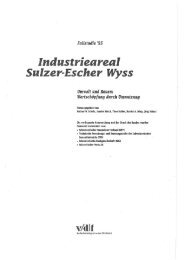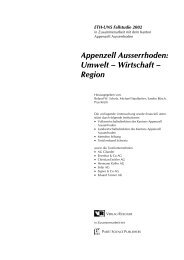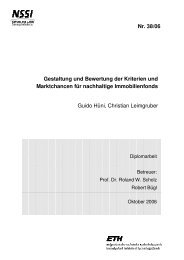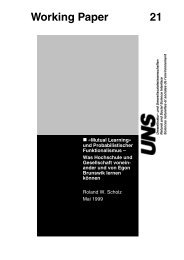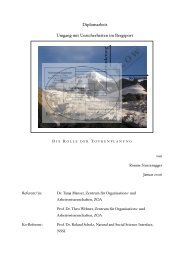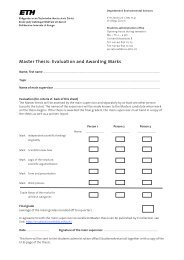The Paradigm of Human-Environment Systems - Natural and Social ...
The Paradigm of Human-Environment Systems - Natural and Social ...
The Paradigm of Human-Environment Systems - Natural and Social ...
You also want an ePaper? Increase the reach of your titles
YUMPU automatically turns print PDFs into web optimized ePapers that Google loves.
<strong>The</strong> <strong>Paradigm</strong> <strong>of</strong> <strong>Human</strong>-<strong>Environment</strong> <strong>Systems</strong><br />
Rol<strong>and</strong> W. Scholz & Claudia R. Binder<br />
Contents<br />
Contents .............................................................................................................................................................................................................................................. 1<br />
Abstract ................................................................................................................................................................................................................................................ 1<br />
<strong>The</strong> Rationale <strong>of</strong> the <strong>Human</strong>-<strong>Environment</strong> <strong>Systems</strong> <strong>Paradigm</strong> .............................................................................................. 2<br />
Structure <strong>of</strong> the paper .................................................................................................................................................................................................. 4<br />
<strong>The</strong>oretical foundations ..................................................................................................................................................................................................... 5<br />
A blueprint <strong>of</strong> a HES-research framework ............................................................................................................................................... 5<br />
A multi-level hierarchy: Conceptualizing human systems ................................................................................................... 8<br />
Adaptation <strong>of</strong> explanatory models <strong>and</strong> environmental dynamics in urban sanitation ...................... 12<br />
Conclusions <strong>and</strong> Outlook ............................................................................................................................................................................................... 17<br />
Acknowledgements .............................................................................................................................................................................................................. 18<br />
References ...................................................................................................................................................................................................................................... 18<br />
Abstract<br />
<strong>Human</strong>-environment systems (HES) are all environmental <strong>and</strong> technological systems<br />
that are relevant for or affected by humans. This paper presents a process structure model<br />
(PSM) to investigate regulatory, feedback, <strong>and</strong> control mechanisms (RFC-mechanisms) in HES.<br />
<strong>The</strong> model separates human <strong>and</strong> environmental systems. <strong>The</strong> interaction between both systems<br />
is given by the environmental awareness <strong>of</strong> humans <strong>and</strong> the short- <strong>and</strong> long-term environmental<br />
impacts <strong>and</strong> feedback loops <strong>of</strong> human action. <strong>Human</strong> decision-making is considered<br />
a key factor in this model, as humans can regulate <strong>and</strong> control the type <strong>of</strong> interaction within<br />
HES. <strong>The</strong> model distinguishes between goal formation, strategy building, strategy evaluation,<br />
action, <strong>and</strong> evaluation/learning. <strong>The</strong> environmental system reacts <strong>and</strong> gives feedback to hu-<br />
man action, allowing for humans to learn <strong>and</strong> adapt their behavior. Evaluation/learning is<br />
based on the feedbacks <strong>of</strong> the environmental system to human action. We distinguish various<br />
types <strong>of</strong> environmental awareness <strong>and</strong> learning, which differ with respect to time <strong>and</strong> spatial<br />
ranges (primary <strong>and</strong> secondary feedback loops). <strong>Human</strong> systems are conceptualized on a multi-<br />
level hierarchy including cell, organ, individual, group, organization, <strong>and</strong> society a systems. Each<br />
level differs in its regulatory <strong>and</strong> control options regarding HES, as well as in the perceived environmental<br />
feedback. We illustrate the model with an example from environmental hygiene.<br />
Key words: <strong>Human</strong>-environment systems, regulatory mechanisms, control mechanisms,<br />
feedback mechanisms, interfering regulatory mechanisms, cholera, the Black Death



